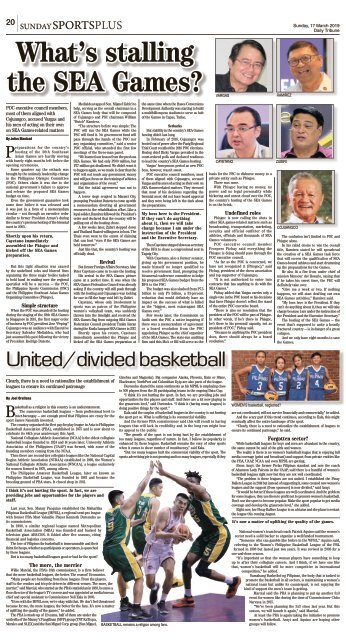17 MARCH 2019
You also want an ePaper? Increase the reach of your titles
YUMPU automatically turns print PDFs into web optimized ePapers that Google loves.
SPORTSPLUS<br />
20<br />
SUNDAY<br />
Sunday, <strong>17</strong> March <strong>2019</strong><br />
Daily Tribune<br />
What’s stalling<br />
the SEA Games?<br />
VARGAS<br />
RAMIREZ<br />
POC executive council members,<br />
most of them aligned with<br />
Cojuangco, accused Vargas and<br />
his men of acting on their own<br />
on SEA Games-related matters<br />
By Julius Manicad<br />
Preparations for the country’s<br />
hosting of the 30th Southeast<br />
Asian Games are hardly moving<br />
with barely eight months left before the<br />
opening ceremonies.<br />
Some quarters say the setback was<br />
brought by the untimely leadership change<br />
in the Philippine Olympic Committee<br />
(POC). Others claim it was due to the<br />
national government’s failure to approve<br />
and release the proposed SEA Games<br />
budget on time.<br />
Even the government guarantee took<br />
some time before it was released and<br />
it was just in a form of a memorandum<br />
circular — not through an executive order<br />
similar to former President Arroyo’s during<br />
the country’s previous hosting of the biennial<br />
meet in 2005.<br />
Shortly upon his return,<br />
Cayetano immediately<br />
assembled the Phisgoc and<br />
kicked off the SEA Games<br />
preparation.<br />
But this tight situation was caused<br />
by the undefined roles and blurred lines<br />
separating the three major bodies tasked<br />
to hold hand in making sure the regional<br />
sportsfest will be a success — the POC,<br />
the Philippine Sports Commission (PSC)<br />
and the Philippine Southeast Asian Games<br />
Organizing Committee (Phisgoc).<br />
Simple structure<br />
When the POC was awarded the hosting<br />
during the staging of the 28th SEA Games<br />
in Singapore in 2015, the first major order<br />
of business by POC president Jose “Peping”<br />
Cojuangco was an audience with Executive<br />
Secretary Salvador Medialdea, who had<br />
just assumed his post following the victory<br />
of President Rodrigo Duterte.<br />
Medialdea tapped Sen. Miguel Zubiri to<br />
help, serving as the overall chairman in a<br />
SEA Games body that will be composed<br />
of Cojuangco and PSC chairman William<br />
“Butch” Ramirez.<br />
“The structure before was simple: The<br />
POC will run the SEA Games while the<br />
PSC will fund it. No government fund will<br />
pass through the hands of the POC nor<br />
any organizing committee,” said a senior<br />
POC official, who attended the first few<br />
meetings of the three-man panel.<br />
“We learned our lesson from the previous<br />
SEA Games. We had only P500 million, but<br />
P27 million got disallowed. We didn’t want it<br />
to happen again, so we made it clear that the<br />
POC will not touch any government money<br />
and will just focus on the training of athletes<br />
and organization of the event.”<br />
But the initial agreement was not to<br />
happen.<br />
A terror siege erupted in Marawi City,<br />
prompting President Duterte to come up with<br />
a memorandum diverting all government<br />
resources to the rehabilitation effort. Like a<br />
loyal solider, Ramirez followed the President’s<br />
order and declared that the country will be<br />
pulling out of the hosting chore.<br />
A few weeks later, Zubiri stepped down<br />
and Thailand floated willingness to host. The<br />
Thais even went to the extent of claiming<br />
that can host “even if the SEA Games are<br />
held tomorrow.”<br />
Just like that, the country’s hosting was<br />
officially dead.<br />
Revival<br />
But former Foreign Affairs Secretary Alan<br />
Peter Cayetano came in to save the hosting.<br />
His arrival in the SEA Games picture<br />
came at a perfect time. It was when the<br />
SEA Games Federation Council was already<br />
asking if the country will still push through<br />
with the hosting and Cojuangco was looking<br />
for one to fill the huge void left by Zubiri.<br />
Cayetano, whose only involvement in<br />
sports was as patron of the Philippine<br />
women’s volleyball team, was suddenly<br />
thrown into the limelight and received the<br />
SEA Games flag from outgoing SEA Games<br />
Federation Council president Tunku Imran<br />
during the Kuala Lumpur SEA Games in 20<strong>17</strong>.<br />
Shortly upon his return, Cayetano<br />
immediately assembled the Phisgoc and<br />
kicked off the SEA Games preparation at<br />
the same time when the Bases Conversions<br />
Development Authority was starting to build<br />
a multibillion-peso stadium to serve as hub<br />
of the Games in Capas, Tarlac.<br />
Setbacks<br />
But stability in the country’s SEA Games<br />
hosting didn’t last long.<br />
In February of 2018, Cojuangco was<br />
booted out of power after the Pasig Regional<br />
Trial Court recalled the 2016 POC elections.<br />
Boxing chief Ricky Vargas prevailed in the<br />
court-ordered polls and declared readiness<br />
to lead the country’s SEA Games hosting.<br />
Vargas’ honeymoon period as new POC<br />
boss, however, wasn’t sweet.<br />
POC executive council members, most<br />
of them aligned with Cojuangco, accused<br />
Vargas and his men of acting on their own on<br />
SEA Games-related matters. They stressed<br />
that most of his decisions regarding the<br />
biennial meet did not have board approval<br />
and they were being left in the dark about<br />
the preparations.<br />
My boss here is the President.<br />
If they can’t do anything<br />
about it, then we will take<br />
charge because I am under the<br />
instruction of the President<br />
and the Executive Secretary.<br />
Then Cayetano stepped down as secretary<br />
of the DFA to chase a congressional seat in<br />
Taguig City.<br />
With Cayetano, also a former senator,<br />
giving up his government position, he<br />
made himself no longer qualified to<br />
receive government fund, prompting the<br />
bicameral conference committee to lodge<br />
his proposed SEA Games budget from the<br />
DFA to the PSC.<br />
The budget was also slashed from P7.5<br />
billion to only P5 billion, a 33-percent<br />
reduction that would definitely have an<br />
impact on the success of what is billed<br />
as the “biggest, most extravagant SEA<br />
Games ever.”<br />
Few weeks later, the Commission on<br />
Audit sent the PSC a notice inquiring if<br />
there was a memorandum of agreement<br />
or a board resolution from the POC<br />
appointing Phisgoc as the chief organizer<br />
of the SEA Games. The state-run auditing<br />
firm said this MoA or BR will serve as the<br />
CAYETANO<br />
basis for the PSC to disburse money to a<br />
private entity such as Phisgoc.<br />
There was none.<br />
With Phisgoc having no money, no<br />
power and no legal personality while<br />
bickering and unrest cloud over the POC,<br />
the country’s hosting of the SEA Games<br />
is on the brink.<br />
Undefined roles<br />
Phisgoc is now calling the shots in<br />
other SEA games-related matters such as<br />
broadcasting, transportation, marketing,<br />
security and official outfitter of the<br />
athletes, officials and thousands of SEA<br />
Games volunteers.<br />
POC executive council member<br />
Prospero Pichay said everything the<br />
Phisgoc is doing should pass through the<br />
POC executive council.<br />
“As far as the POC is concerned, we<br />
have not recognized it (Phisgoc),” said<br />
Pichay, president of the chess association<br />
and top supporter of Cojuangco.<br />
“It is not authorized to enter into<br />
contracts that has anything to do with the<br />
SEA Games.”<br />
Pichay added that Vargas carries only a<br />
single vote in the POC board so his decisions<br />
that favor Phisgoc doesn’t reflect the stand<br />
of the entire POC executive board.<br />
“There is also no resolution that the<br />
president of the POC will be part of Phisgoc.<br />
In other words, if he’s there in Phisgoc,<br />
he’s there in his personal capacity, not as<br />
president of POC,” Pichay said.<br />
“Because in anything the POC president<br />
does, there should always be a board<br />
resolution.”<br />
ZUBIRI<br />
COJUANGCO<br />
The confusion isn’t limited to POC and<br />
Phisgoc alone.<br />
In his rabid desire to win the overall<br />
title, Ramirez stated he will spearhead<br />
the creation of a SEA Games task force<br />
that will screen the qualification of SEA<br />
Games-bound athletes and start drumming<br />
up the preparations for the Games.<br />
He also lit a fire from under chief of<br />
mission Monsour del Rosario, saying that<br />
if he takes his sweet time, the PSC will<br />
definitely take over.<br />
“Give me a week or two. If nothing<br />
happens, we will start drafting our own<br />
SEA Games activities,” Ramirez said.<br />
“My boss here is the President. If they<br />
can’t do anything about it, then we will take<br />
charge because I am under the instruction of<br />
the President and the Executive Secretary.”<br />
The hosting of the SEA Games — the<br />
event that’s supposed to unite a heavily<br />
fractured country — is in danger of a great<br />
collapse.<br />
And we only have eight months to save<br />
the Games.<br />
United/divided basketball<br />
Clearly, there is a need to rationalize the establishment of<br />
leagues to ensure its continued patronage<br />
By Joel Orellana<br />
Basketball as a religion in this country is an understatement.<br />
The numerous basketball leagues — from professional level to<br />
inter-barangay — are enough proof that Filipinos are crazy for the<br />
sport James Naismith invented.<br />
The country organized the first pay-for-play league in Asia in Philippine<br />
Basketball Association (PBA), established in 1975 and is now about to<br />
celebrate its 44th year anniversary this April.<br />
National Collegiate Athletic Association (NCAA) is the oldest collegiate<br />
basketball league founded in 1924 and 14 years later, University Athletic<br />
Association of the Philippines (UAAP) was formed, with some of the<br />
founding members coming from the NCAA.<br />
Then there are second-tier collegiate leagues like the National Capital<br />
Region Athletic Association (NCRAA) established in 1993, the Women’s<br />
National Collegiate Athletic Association (WNCAA), a league exclusively<br />
for women formed in 1970, among others.<br />
The Philippine Amateur Basketball League, later on known as<br />
Philippine Basketball League, was founded in 1983 and became the<br />
breeding ground of PBA stars. It closed shop in 2011.<br />
I think it’s not hurting the sport. In fact, we are<br />
providing jobs and opportunities for the players and<br />
staff.<br />
Last year, Sen. Manny Pacquiao established the Maharlika<br />
Pilipinas Basketball League (MPBL), a regional semi-pro league<br />
with former PBA Most Valuable Player Kenneth Duremdes as<br />
its commissioner.<br />
In 1998, a similar regional league named Metropolitan<br />
Basketball Association (MBA) was founded and backed by<br />
television giant ABS-CBN. It folded after five seasons, citing<br />
financial and logistics concerns.<br />
The love of Filipinos for basketball is immeasurable and their<br />
thirst for hoops, whether as participants or spectators, is quenched<br />
by these leagues.<br />
But is too many basketball leagues good or bad for the sport?<br />
The more, the merrier<br />
Willie Marcial, the PBA’s 10th commissioner, is a firm believer<br />
that the more basketball leagues, the better. The reason? Economics.<br />
“Many people are benefiting from these leagues. From the players,<br />
staff to the vendors and tricycle drivers in different venues. The more, the<br />
merrier,” said Marcial, who started as the PBA’s statistician in 1983, became a<br />
floor director of the league’s TV coveror and was appointed as media bureau<br />
chief and special assistant to Commissioner Noli Eala in 2003.<br />
“Even with the MPBL now, we’re okay with that. We don’t feel threatened<br />
because for me, the more leagues, the better for the fans. It’s now a matter<br />
of uplifting the quality of the games,” he added.<br />
The PBA is made up of 12 teams, half of them are under the<br />
umbrella of the Manny V. Pangilinan (MVP) group (TNT KaTropa,<br />
Meralco and NLEX) and the San Miguel Corp. group (San Miguel,<br />
Ginebra and Magnolia). Big companies Alaska, Phoenix, Rain or Shine,<br />
Blackwater, NorthPort and Columbian Dyip are also parts of the league.<br />
Duremdes shared the same sentiments as his MPBL is employing close<br />
to 500 players from the 26 participating teams in the ongoing Datu Cup.<br />
“I think it’s not hurting the sport. In fact, we are providing jobs and<br />
opportunities for the players and staff. And there are a lot now playing in<br />
the grassroots level,” said Duremdes. “I think it (having many leagues) is<br />
doing positive things for the sport.”<br />
Eala said the surplus of basketball leagues in the country is not hurting<br />
the sport per se. What is suffering is its commercial viability.<br />
And the former PBA commissioner said this will result in having<br />
leagues that will lack in credibility and in the long run might lose<br />
its appeal to the public.<br />
“The growth of the sport is not being hurt by the establishment of<br />
too many leagues, regardless of nature. In fact, I believe its popularity is<br />
enhanced by these leagues. Basketball remains the envy of other sports<br />
when it comes to sheer number of constituency,” said Eala.<br />
“But too many leagues hurt the commercial viability of the sport. The<br />
sports advertising pie is not growing and too many leagues, especially if they<br />
BASKETBALL remains a religion among fans.<br />
WOMEN’S basketball, neglected?<br />
are not coordinated, will not survive financially and commercially,” he added.<br />
And the scary part if this trend continues, according to Eala, this might<br />
eventually affect the entire landscape of the sport.<br />
“Clearly, there is a need to rationalize the establishment of leagues to<br />
ensure its continued patronage,” he said.<br />
Forgotten sector?<br />
While basketball leagues for boys and men are abundant in the country,<br />
the same cannot be said of the girls and women.<br />
The reality is there is no women’s basketball league that is enjoying full<br />
media coverage (print and broadcast) and support from private entities like<br />
the PBA, UAAP, NCAA and even MPBL are getting.<br />
Ewon Arayi, the former Perlas Pilipinas standout and now the coach<br />
of Adamson Lady Falcons in the UAAP, said there is a handful of women’s<br />
basketball leagues right now but they are not well coordinated.<br />
“The problem is these leagues are not united. I established the Pinay<br />
Ballers League in 2014 but instead of supporting it, some created new women’s<br />
leagues and the support (from sponsors) is now divided,” said Arayi.<br />
“It would be better if these leagues are well coordinated. And the problem<br />
for some leagues, they use them to profit not to promote women’s basketball.<br />
Don’t use the sport to become popular. Make the sport popular to get media<br />
coverage and develop the grassroots level,” she added.<br />
Right now, her Pinay Ballers League is on a hiatus and she plans to restart<br />
the league this coming August.<br />
It’s now a matter of uplifting the quality of the games.<br />
National women’s team head coach Patrick Aquino said the women’s<br />
sector need a solid backer to organize a well-funded tournament.<br />
“Someone who can gamble like before in the WPBL,” Aquino said,<br />
referring to the Women’s Philippine Basketball League of the PBL<br />
formed in 1998 but lasted just two years. It was revived in 2008 for a<br />
one-and-done season.<br />
“It’s important so that the woman players have something to loop<br />
up to after their collegiate careers. And I think, if we have one like<br />
that, women’s basketball will be more competitive in international<br />
competition,” he added.<br />
Samahang Basketbol ng Pilipinas, the body that is tasked to<br />
promote the basketball in all sectors, is maintaining a women’s<br />
national team but unlike its counterpart, is not enjoying the<br />
kind of support the men’s team is getting.<br />
Marcial said the PBA is planning to put up another 3x3<br />
event for women like during the time of Commissioner Chito<br />
Narvasa in 2015.<br />
“We’ve been planning the 3x3 since last year. But this<br />
season, we will launch it again,” said Marcial.<br />
At least the PBA is again taking the initiative to promote<br />
women’s basketball. Arayi and Aquino are hoping other<br />
groups will follow.


















